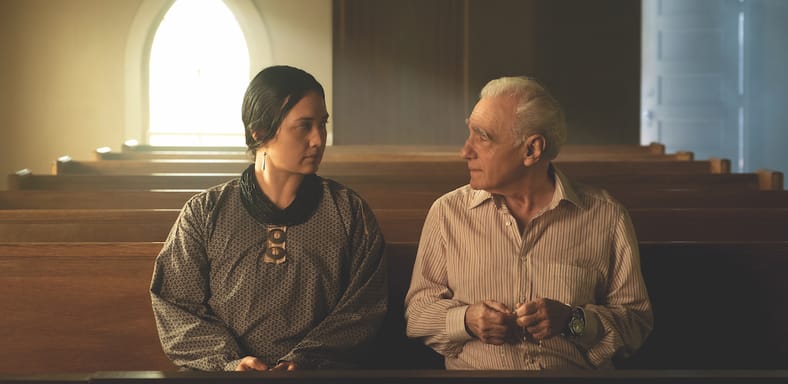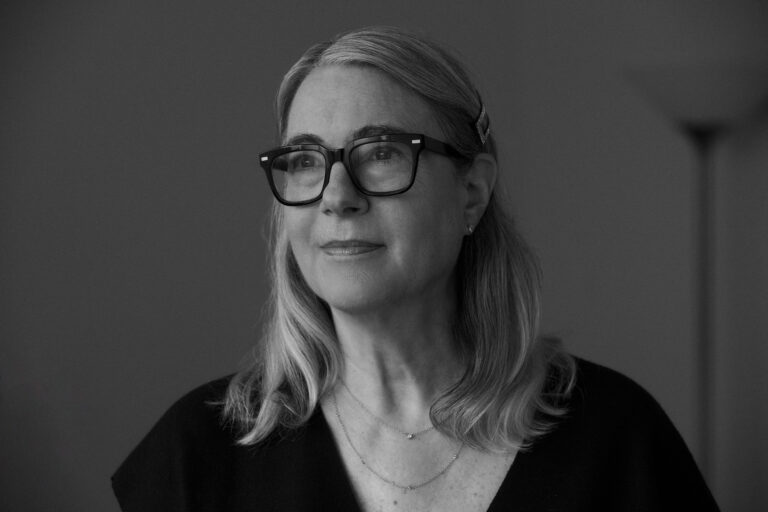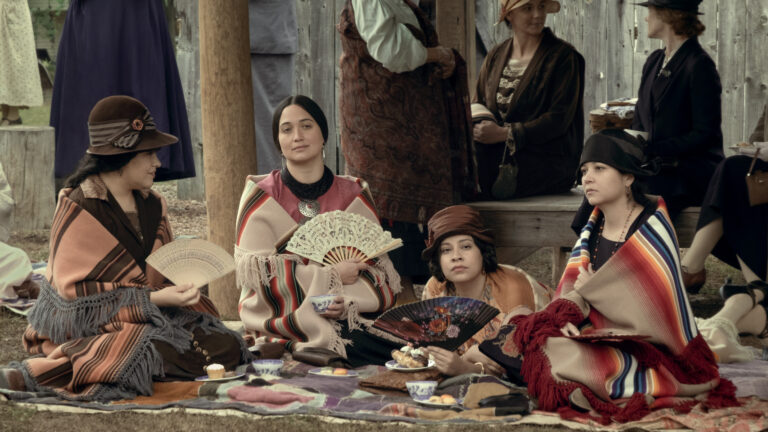
Killers of the Flower Moon casting director Ellen Lewis knew from the start that Leonardo DiCaprio and Robert DeNiro would star: The film is Martin Scorsese’s sixth collaboration with DiCaprio, and tenth with DeNiro, making the pair his most reliable leads.
But that left dozens of Killers of the Flower Moon roles to fill — including 44 roles for Osage actors, who were integral to telling the Oklahoma-set true story of the white killers behind a Reign of Terror they plotted a century ago to steal Osage riches.
Lewis, a three-time Emmy winner who has worked with Scorsese for 32 years on projects from Goodfellas to The Departed to The Irishman, started by looking at people from the time of the story. She studied archival images assembled by Marianne Bower, one of the executive producers of the film, based on the 2017 nonfiction book of the same title by David Grann.

“Casting directors are among the first people who come onto a film, outside of the writer and obviously the director. So very early, especially in a Martin Scorsese film, I will start getting research material,” Lewis says. ”We got home movies from the Rotary Club and home movies of the Osage from the 1920s, and photographs of people who are part of this story.
“But it’s not about lookalikes — I always say this, it’s not about having a lookalike, but it’s the essence. So you get a feeling for the period of the movie, and it just starts kind of formulating almost in my imagination.”
Then she reached out to Rene Haynes, with whom she had worked on Netflix’s Godless.
“She had read the book, and she said, ‘I was hoping you would call,’” says Lewis.
Renee Haynes on Casting Indigenous Actors
Though she doesn’t have an Indigenous background, Haynes is one of Hollywood’s most-sought casting directors for Native American actors. Haynes’ family moved from the Los Angeles area to Montana when she was in high school, and because of her early work in theater, an L.A. casting director hired her to go on casting calls around Montana reservations for a 1988 film called War Party.
Hollywood’s portrayal of Indigenous people has often teetered between ignorant and shameful, and the people of the Blackfeet Nation in northwestern Montana, where Haynes was asked to hire extras, were rightly cautious. She remembers a War Party casting call in a church basement.
“Maybe one or two people trickled in, but that was it, in the morning. And around lunchtime, a bunch of people from the tribal council showed up to see how things were going and to ask what was going on. And at the same time, this gentleman came in who was obviously very down on his luck.”
She asked the man to fill out an application to be an extra, but he said he couldn’t read. So she walked him through each question and filled it out for him. She asked for his address, but he said he had no home. So she promised him a job as an extra if he could find a way to call her.
Almost no one else showed up until the end of the day, when a tiny older woman came in and sat far from Haynes. Haynes asked her if she wanted to be in the film, and again walked her through the process. When she turned to get a pen, she heard a rustle of activity: “It was the little grandma with a wig, pulling it off, and a man’s voice — it was the same gentleman from before.”

She quickly understood what the Blackfeet Nation had done: “They were testing us, testing Hollywood, to see if we treated everyone, no matter what their circumstances — down on their luck, elderly — with the same dignity. And this was my very first job. And I have carried that principle, and what I learned there, into every job I’ve ever done since.”
Coincidentally, at around the same time, a baby was born nearby who would grow up on the Blackfeet Reservation. Her name was Lily Gladstone, and she was to become an actress — and one of the stars of Killers of the Flower Moon.
Killers of the Flower Moon and Respect
The Killers of the Flower Moon film adaptation began when DiCaprio, a longtime supporter of Indigenous nations, optioned the rights to Grann’s manuscript in 2016, before it was published, and began trying to persuade Scorsese to direct.
Scorsese was editing his film Silence at the time, and was preparing 2019’s The Irishman. But he began working closely with screenwriter Eric Roth in January 2017 to adapt Killers.
Scorsese had loved the Westerns of his childhood, though he recognized their flaws. “Those films nourished me as a filmmaker, but they also inspired me to go deeper into the real history,” he says in the press notes for Killers of the Flower Moon.
Determined not to repeat the failures of past filmmakers, Scorsese and his team tried to involve the Osage closely from the beginning, traveling to the Osage reservation, about an hour from Tulsa, in the spring of 2019 to scout locations and meet with members of the community, including Geoffrey Standing Bear, the Osage Nation’s principal chief.
“I didn’t want the Osage shown as just a bunch of bodies lying around. We were hoping the history and culture would be accurately represented in his movie,” Standing Bear says in a statement. “Mr. Scorsese was so respectful in the way he and his people came to us. And he pointed out some of the movies he had made, in particular Silence, in which the cultures of Christian missionaries and 17th-century Japan were presented in a serious and respectful manner, and that was so encouraging.”
Later, the Gray Horse Osage community hosted a dinner for the Killers of the Flower Moon filmmakers, attended by more than a hundred tribal members. Many had family members who were murdered during the Reign of Terror.
“Mr. Scorsese went around and shook the hand of every single Osage who had attended,” recalls Osage Nation Congresswoman Brandy Lemon, who became a liaison between the Osage community and the filmmakers.
The productive and respectful early meetings cleared the way for a wide-scale Indigenous casting process.
“We were first in Pawhuska, where the Osage predominantly live,” recalls Lewis. “Anybody who wanted to be seen came in, and we were meeting them and reading people. Then we went to Oklahoma City, and then we went to Tulsa. So we saw a total of, I think, between 2,400 and 2,500 people during that time.”
Adds Haynes: “Maybe nine or 10 of the 66 speaking roles for Indigenous people went to professional actors we brought in. And then so many of the others were locals found through that open call.”
The film’s main casting principle was that whenever possible, Osage characters would be played by Osage actors, and if not by an Osage actor, then by a Native American. The Osage performers make an especially strong impression in scenes depicting real-life Osage ceremonies.
The most important role was Mollie Burkhart, the woman played by Gladstone, upon whom the film revolves. From both the Blackfeet and Nez Perce nations, she has a long acting resume, but especially stood out to Lewis and Haynes because of her work in the 2016 Kelly Reichardt drama Certain Women.
“It was really clear, pretty early, what a wonderful actor she is and what a beautiful presence Lily has,” Lewis says. “I felt pretty confident, early, that Lily was gonna get this part. … She’s just a fantastic actress and an amazing person.”
Gladstone’s Mollie is whimsical, suspicious, and strong — even when near death. She’s a steady, sympathetic presence surrounded by a loving family — including Tantoo Cardinal as her mother, Lizzie Q — but also by a rogue’s gallery of fortune-seeking men, led by De Niro’s William Hale and assisted by Mollie’s malleable husband, DiCaprio’s Ernest Burkhart.
Lewis delighted in filling Killers of the Flower Moon with memorable mugs, some classic-movie handsome, some character-actor plucky, and drew heavily from the world of music: Jack White, Pete Yorn, and Sturgill Simpson are among the singer-songwriters on hand.
She started out as an assistant to casting agent Juliet Taylor, known for films from The Exorcist to Scorsese’s Taxi Driver to Schindler’s List, as well as dozens of Woody Allen films. Lewis found that she had a knack for putting people at ease and helping them do their best in auditions.
“It’s just about being really open to faces,” says Lewis. “Then I just start reading people.”
Killers of the Flower Moon arrives in theaters on October 20, from Apple Original Films, and streams soon on Apple TV+.
Main image: Killers of the Flower Moon star Lily Gladstone and director Martin Scorsese. Photo Credit: Melinda Sue Gordon. Courtesy of Apple.
Share:

